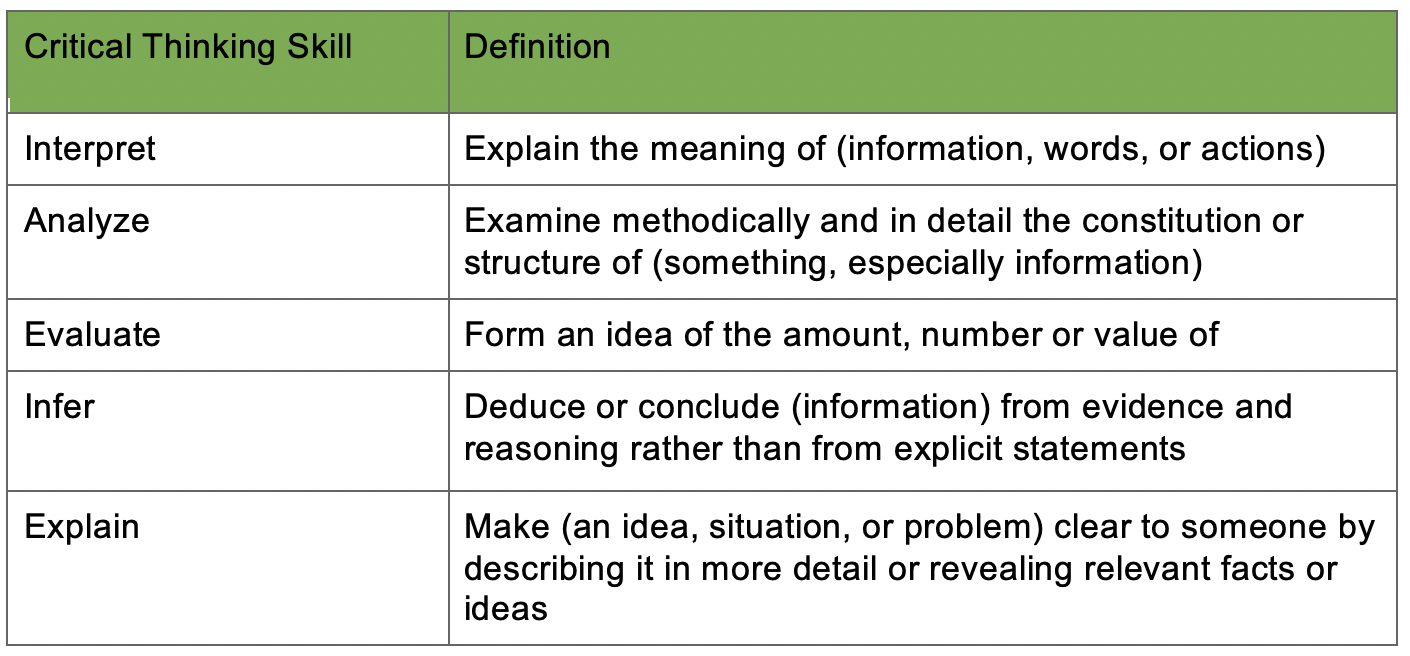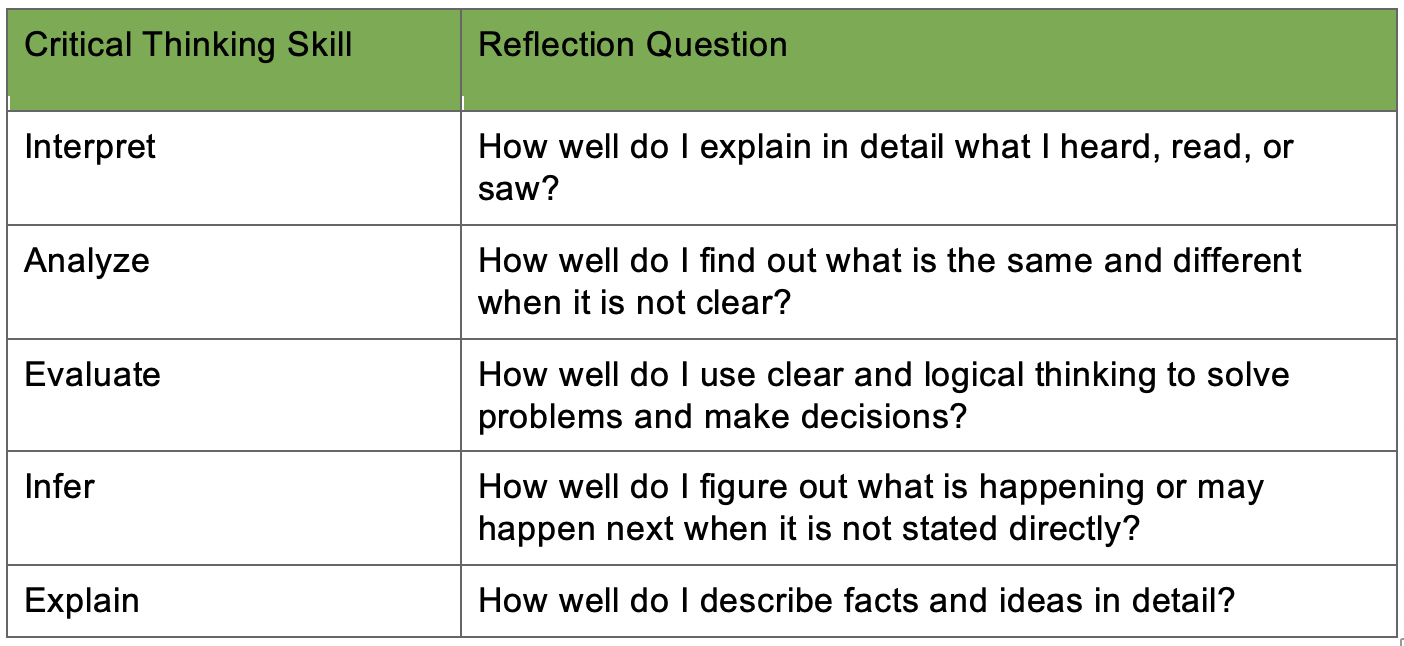
This is the second in a series of blog posts focused on critical thinking.
Part 1 focused on designing a PBL project for critical thinking. In this post, we discuss how to teach critical thinking in projects. Part 3 will focus on how to measure critical thinking in projects.
Here are three research-based insights to help guide how you teach critical thinking in projects.
1. Critical thinking is comprised of five distinct but related skills.
The definition of critical thinking includes these cognitive skills: interpretation, analysis, evaluation, inference, and explanation. Students who are good critical thinkers have these skills and they apply them.1

Our advice: Teach specific critical thinking skills and pay attention to critical thinking overall.
Students develop and apply different critical thinking skills at different times and to different degrees depending on the project that they are designing and facilitating. This means that teachers need to teach critical thinking using a foreground (skills explicitly taught and assessed) and background (skills that are practiced but not the focus of instruction and assessment) approach.
Foreground: As you review the critical thinking skills, consider which one(s) are most appropriate for your project content, goals, or product. These can change within and across projects.
Background: Once you have selected your target critical thinking skills, be aware of the differences between them and be sure that you teach all of these skills across projects. Remember, just because a student can demonstrate interpretation, for example, in one project does not mean that they have mastered critical thinking. To be a good critical thinker, students must demonstrate all five skills across projects.
2. Critical thinking skills vary across content areas.
Researchers debate whether it is more effective to teach critical thinking within a content area or as a generic skill that can be applied across content areas. Consensus is that both have merit for teaching critical thinking in projects. This is because critical thinking skills vary by content area, and they are sufficiently complex that they need to be taught separately as well.
“For example, in history, students need to interpret documents in light of their sources, seek corroboration and put them in their historical context. That kind of analysis isn’t relevant in science, where the source of a document isn’t as important as following the scientific method.”2 Interpretation, analysis, evaluation, inference, and explanation are all skills that cut across content areas and need explicit instruction.3
Our advice: Introduce a critical thinking skill out of context first, then teach it in the context of content areas.
Start with an accessible example that students can easily tackle before diving into teaching critical thinking in a content area. For inference, you could show a picture of an open, empty bird cage with the door wide open and a cat sitting nearby with feathers in its mouth, and ask: What do you infer happened in this picture?
This approach helps students understand what inference (or any critical thinking skill) means before learning within the context of a content area, which is more cognitively demanding. Scaffolding the development of critical thinking skills in this way reduces the cognitive demand so that students are better to use the critical thinking skill(s) in a content area.
3. Critical thinking does not automatically transfer from one content area of context to another.
Students need help to transfer critical thinking from one content area or context to another. Metacognition, or thinking about thinking, helps students to transfer or adapt their learning to new contexts or tasks. Decades of research on how people learn shows that teachers can help students develop metacognitive skills through modeling, formative assessment and feedback opportunities, and student self-reflection.4
Our advice: Use modeling, feedback, and reflection strategies to ensure that learning transfers across content areas and experience.
Modeling: Unlike riding a bike, critical thinking is primarily an internal process. It is difficult to see it in action. Teachers can de-privatize the process by modeling their internal conversation as they work on a task or problem that requires critical thinking. When teachers verbalize how they approach a problem, students gain insight into expert thinking that they can then use to tackle similar problems.
Feedback: Research shows that frequent feedback from teachers results in student learning gains5 and offers students another way to “think about their thinking.”6 Feedback doesn’t have to be formal. Formative assessments offer quick and effective ways to give students real-time feedback that can help them to develop critical thinking. Consider these simple informal and formal strategies that you can use in projects.7

Reflection: Self-reflection or self-assessment can help make critical thinking “stick.” One way to do this is to have students reflect on their critical thinking is to pick on one the critical thinking skills that focused on in a project and respond to simple questions. This will help them gauge their development of critical thinking and internalize what critical thinking is.

____________________________________________
End Notes:
1. Facione, P. (1990). Critical thinking: A statement of expert consensus for the purposes of educational assessment and instruction. Newark: DE: American Philosophical Association, p. 3.
https://files.eric.ed.gov/fulltext/ED315423.pdf
2. Barshay, J. (2019). Scientific Research on How to Teach Critical Thinking Contradicts Education Trends. The Hechinger Report. https://hechingerreport.org/scientific-research-on-how-to-teach-critical-thinking-contradicts-education-trends
3. Abrami, P. C., Bernard, R. M., Borokhovski, E., Wade, A., Surkes, M. A., Tamim, R., & Zhang, D. (2008). Instructional interventions affecting critical thinking skills and dispositions: A stage 1 meta-analysis. Review of Educational Research, 78(4), 1102–1134. https://doi.org/10.3102/0034654308326084
4. National Research Council. (2000). How people learn: Brain, mind, experience, and school: Expanded edition. Washington, DC: National Academies Press. https://doi.org/10.17226/9853; and National Academies of Sciences (2018). How people learn II: Learners, contexts, and cultures. https://doi.org/10.17226/24783
5. Black, P., & Williams, D. (1998). Assessment and classroom learning. Assessment in Education: Principles, Policy & Practice, 5(1), 7–73.
6. Wiggins, G. (2012). Seven Keys to Effective Feedback. ASCD Educational Leadership, 7(1), p. 10-16.
http://www.ascd.org/publications/educational-leadership/sept12/vol70/num01/Seven-Keys-to-Effective-Feedback.aspx
7. PBLWorks (2019). PBL 101 Workbook. Novato, CA: Author.


